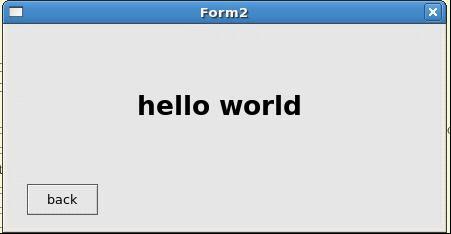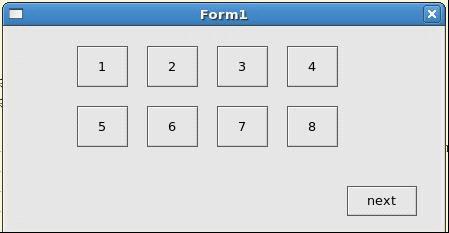不浮躁
分类: 嵌入式
2015-02-02 16:50:19
review
.ui 生成 .h .cpp文件
uic form1.ui -o form1.h
uic form1.ui -i form1.h -o form1.cpp
C++三个特点 :继承 重载 封装
Qt事件
Qt程序是事件驱动的, 程序的每个动作都是由幕后某个事件所触发.
Qt事件的类型很多, 常见的qt的事件如下:
键盘事件: 按键按下和松开.
鼠标事件: 鼠标移动,鼠标按键的按下和松开.
拖放事件: 用鼠标进行拖放.
滚轮事件: 鼠标滚轮滚动.
绘屏事件: 重绘屏幕的某些部分.
定时事件: 定时器到时.
焦点事件: 键盘焦点移动.
进入和离开事件: 鼠标移入widget之内,或是移出.
移动事件: widget的位置改变.
大小改变事件: widget的大小改变.
显示和隐藏事件: widget显示和隐藏.
窗口事件: 窗口是否为当前窗口.
还有一些非常见的qt事件,比如socket事件,剪贴板事件,字体改变,布局改变等等.
Qt 的事件和Qt中的signal不一样. 后者通常用来使用widget, 而前者用来实现 widget.
比如一个按钮, 我们使用这个按钮的时候, 我们只关心他clicked()的signal, 至于这个按钮如何接收处理鼠标事件,再发射这个信号,我们是不用关心的. 但是如果我们要重载一个按钮的时候,我们就要面对event了. 比如我们可以改变它的行为,在鼠标按键按下的时候(mouse press event) 就触发clicked()的signal而不是通常在释放的( mouse release event)时候.
事件起源:
基于事件如何被产生与分发,可以把事件分为三类:
1)Spontaneous 事件
2) Posted 事件
3)Sent 事件
1)Spontaneous 事件,由窗口系统产生,它们被放到系统队列中,通过事件循环逐个处理。
本类事件通常是window system把从系统得到的消息,比如鼠标按键,键盘按键等, 放入系统的消息队列中. Qt事件循环的时候读取这些事件,转化为QEvent,再依次处理.
2)Posted 事件,由Qt或是应用程序产生,它们被Qt组成队列,再通过事件循环处理。
调用QApplication::postEvent()来产生一个posted类型事件.
例如:QWidget::update()函数
当需要重新绘制屏幕时,程序调用update()函数
其实现的原理是new出一个paintEvent,调用 QApplication::postEvent(),将其放入Qt的消息队列中,等待依次被处理.
3)Sent 事件由Qt或是应用程序产生,但它们被直接发送到目标对象。
调用QApplication::sendEvent()函数来产生一个sent类型事件.
sent 类型事件不会放入队列, 而是直接被派发和处理, QWidget::repaint()函数用的就是这种方式.
当我们在main()函数的末尾调用QApplication::exec()时,程序进入了Qt的事件循环
事件循环如下面所示:
while (!exit_was_called)
{
while(!posted_event_queue_is_empty)
{
process_next_posted_event();
}
while(!spontaneous_event_queue_is_empty)
{
process_next_spontaneous_event();
}
while(!posted_event_queue_is_empty)
{
process_next_posted_event();
}
}
事件循环的处理流程:
1)先处理Qt事件队列中的posted事件,直至为空
2)再处理系统消息队列中的spontaneous消息,直至为空
3)在处理系统消息的时候会产生新的Qt posted事件,需要对其再次进行处理
不通过事件循环
sendEvent的事件派发不通过事件循环。QApplication::sendEvent()是通过调用QApplication::notify(),直接进入了事件的派发和处理环节。
Notify
调用QApplication::sendEvent的时候, 消息会立即被处理,是同步的. 实际上QApplication::sendEvent()是通过调用QApplication::notify(), 直接进入了事件的派发和处理环节.所有的事件都最终通过 notify 派发到相应的对象中。
bool QApplication::notify ( QObject * receiver, QEvent * event )
它是通过调用receiver->event(event) 来实现的。
目标接受对象的event方法会自动接受notify传来的event事件
event() 会返回一个布尔值,来告诉调用者是否事件被accept或ignore,
(true表示accept),从event()返回的布尔值却是用来与QApplication:notify()通讯的
event()函数的处理如下所示:
bool QWidget::event(QEvent *event)
{
switch (e->type()) {
case QEvent::KeyPress:
keyPressEvent((QKeyEvent *)event);
if (!((QKeyEvent *)event)->isAccepted())
return false;
break;
case QEvent::KeyRelease:
keyReleaseEvent((QKeyEvent *)event);
if (!((QKeyEvent *)event)->isAccepted())
return false;
break;
...
}
return true;
}
Close事件有点不同,调用QCloseEvent:ignore()取消了关闭操作,而accept()告诉Qt继续执行正常的关闭操作。为了避免混乱,最好是在closeEvent()的新实现中明确地进行accept()与ignore()的调用:、
void MainWindow::closeEvent(QCloseEvent *event)
{
if (userReallyWantsToQuit()) {
event->accept();
} else {
event->ignore();
}
}
在空白窗体页面,重载当前窗体类的keyPressEvent方法,实现按键事件的响应。
步骤一:
添加头文件
在form.cpp中填加void Form1::keyPressEvent(QKeyEvent *k )
并实现根据不同的键值,执行不同的动作。
步骤二:
添加头文件
在form.h 中为窗体类form1添加 void keyPressEvent(QKeyEvent *k )声明;
步骤三:
重新编译工程并运行测试。
void Form1::keyPressEvent( QKeyEvent *k )
{
if(k->key() == Key_Left)
{
qDebug("Left\n");
....
}
else if(k->key() == Key_Right)
{
qDebug("Right\n");
...
}
else QWidget::keyPressEvent(k);
}
在具备子控件的复杂窗体中,重载当前窗体类的keyPressEvent方法,实现按键事件的响应。
步骤一:
添加头文件
在form.cpp中填加void Form1::keyPressEvent(QKeyEvent *k )
并实现根据不同的键值,执行不同的动作。
步骤二:
添加头文件
在form.h 中为窗体类form1添加 void keyPressEvent(QKeyEvent *k )声明;
步骤三:
在form.cpp中,消除子控件的焦点策略,使能方向及Tab按键功能。
步骤四:
重新编译工程并运行测试。
例如:
pushButton1 = new QPushButton( this, "pushButton1" );
pushButton1->setGeometry( QRect( 200, 150, 111, 41 ) );
pushButton1->setFocusPolicy(QWidget::NoFocus);
void QWidget::setFocusPolicy ( FocusPolicy )
设置这个窗口部件接收键盘焦点的方式。
“focusPolicy”属性保存的是窗口部件接收键盘焦点的策略。
如果窗口部件通过tab来接收键盘焦点,这个策略就是QWidget::TabFocus;
如果窗口部件通过点击来接收键盘焦点,这个策略就是QWidget::ClickFocus;
如果窗口部件上述两种方式都使用,是QWidget::StrongFocus;
如果它不接收焦点(QWidget的默认值),是QWidget::NoFocus。
重载当前窗体类的event方法,实现针对性事件的处理与过滤效果。
步骤一:
在form.cpp中填加bool Form1::event(QEvent *event)
并实现根据不同的键值,执行不同的动作。
步骤二:
在form.h 中为窗体类form1添加 bool event(QEvent *event)声明;
步骤三:
重新编译工程并运行测试。
bool Form1::event(QEvent * event)
{
if (event->type() == QEvent::KeyPress)
{
QKeyEvent *keyEvent = (QKeyEvent *) event;
if (keyEvent->key() == Key_A)
{
qDebug("--cut the Key_A--\n");
return true;
}
}
return QWidget::event(event);
}
实验:
1)用鼠标事件实现鼠标放在按钮上,按钮变大。
2)用按键事件实现方向右和方向左键控制2个窗口
3)用信号与槽机制实现鼠标点击next和back实现控制2个窗口
main.cpp:
form1.cpp
form2.cpp

